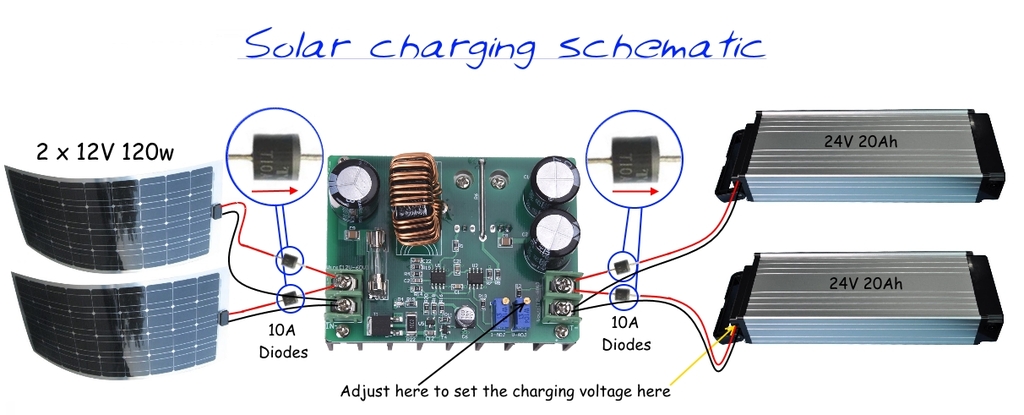Hi Erik and

to the forum.
I would connect both solar panels in parallel and then connect them to
a suitable DC:DC step-up converter to boost the voltage to the required charging voltage
(28.8~29.2V @ 3.60~3.65V per cell). The output can be adjusted with the aid of a small screwdriver to adjust the preset potentiometer, and a voltmeter to measure the open circuit voltage output from the DC:DC converter on the battery side of the diodes.
It is very important the maximum output voltage is set correctly
(ideally the same voltage as your charger's regulated output) or it might be possible to overcharge the batteries or overload the battery's
BMS if the output voltage is too high.
The output would be split to each of the batteries wired in parallel using a common ground connection
(battery negative) but with two separate positive feeds, each wire fitted with a
10 Amp diode to prevent a direct connection between the two batteries. The
BMS should prevent high current from flowing between the batteries if one battery was at a much higher voltage than the other when initially connected, but the diodes will definitely prevent this from happening even if the
BMS doesn't.
The diodes would also prevent the solar panels from draining current when they are in the shade. It might be beneficial to fit a
10 A diode on each of the solar panel's positive output wires so that if one panel is in the shade, it won't affect the output of the other.

If the battery voltages are not the same, the lowest of the two batteries would absorb the majority of the charge current until its voltage reached the same voltage as the other battery. At this point, the charge would be split evenly between the two batteries until they become fully charged, and the Battery's
BMS should prevent the possibility of the battery
(or a single weak cell) being overcharged.
At 120W per panel
(and the converter running at 85% efficiency) the maximum charge current would be somewhere between 8.5A @24V and 7A @ 29.2V, which a single 20Ah battery should be able to accept on its own without any problem.
I have not actually tested a setup like this, but I see no reason why it shouldn't work as expected, and it's not as if you are having to spend a huge sum of money in order to find out for sure.
I'm not sure how hot hot the heatsink will get on the converter with continual use, so it might be advisable to add an electric cooling fan powered from the solar panels 12V output and switched via a thermostatically controlled switch.
Alan